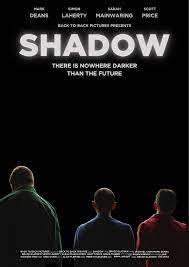
SHADOW
Australia, 2021, 56 minutes, Colour.
Mark Deans, Simon Laherty, Sarah Mainwaring, Scott Price, Michael Chan, Bruce Gladwin.
Directed by Bruce Gladwin..
This is a brief feature film, made by the Back-to-Back Theatre group, based on a play that the group had developed over some years, Shadow, Whose Prey the Hunter Becomes. It was filmed in Geelong, some scenes of Corio Bay, but most of the action in The Playhouse.
The principal reason for seeing this film is that it focuses on men and women with disabilities, although there is a lot of discussion about the nature of disability, the use of the word, especially concerning brain functioning,
And the film was written and performed by the cast with disabilities, and filmed with a crew with disabilities, 95% of them, but with professional mentors.
The dialogue of the film was worked on by its four central characters. And they perform, dramatise their situations. While this film is important for audiences to appreciate men and women with disabilities, to watch, to listen, not to judge, but to appreciate and understand, the development of the plot is not what audiences might expect.
The cast and audience gather in the foyer of The Playhouse, the cinema audience entering with them, everyone finding a place to observe the action. Our attention has been alerted in the foyer by a rather genial character, Mark, with Down Syndrome. And we glance around to see the other men and women present, the way they look, the way they observe, most of them not contributing verbally to the action. There are some of the carers present amongst the audience and a journalist who arrives late, takes notes throughout.
The situation is that this is a town meeting, with Simon, middle-aged, articulate in his way, unable to explain his situation as regards ideas, thinking, expression, but continually upstaged by Scott, who explains that he has mental disability but is autistic, not hesitating to intervene, drawing on information expertise, Moody, defying Simon, sometimes walking out, but returning and intervening and intruding. But, the character who demands most attention is Sarah, 36, articulate but expressing herself slowly and deliberately. It is she who raises objections about the language of disability. She is assertive on her own condition but also what she can achieve. Along with Scott, she has the most lines. She also suggests using the language of “neurodiversity”.
But the situation is not what we expect. The group has the intention of bettering the world, saving the world. Ideals are propounded, Simon trying to manage the meeting, Scott raising all kinds of complexities, Sarah making her stances, Mark in the audience, smiling, focusing on his food. The upshot of the discussion is the question about whether the world can be saved, whether this group is able to do any saving, conscious as they are of their strengths and disabilities, needing to save themselves before they can save the world.
This is a brief film that would contribute to “normal” (the word used by the actors for reference) audiences understanding the nature of mental disabilities, making them pause, non-judgemental, adapting expectations, finding ways to collaborate and to contribute to understanding and appreciation. As has happened with Back-to-Back Theatre and this film.